March 10, 2025 · 13 min read
The Future of Smart Cities: How AI and IoT Are Reshaping Urban Life

Shaimaa Badawi
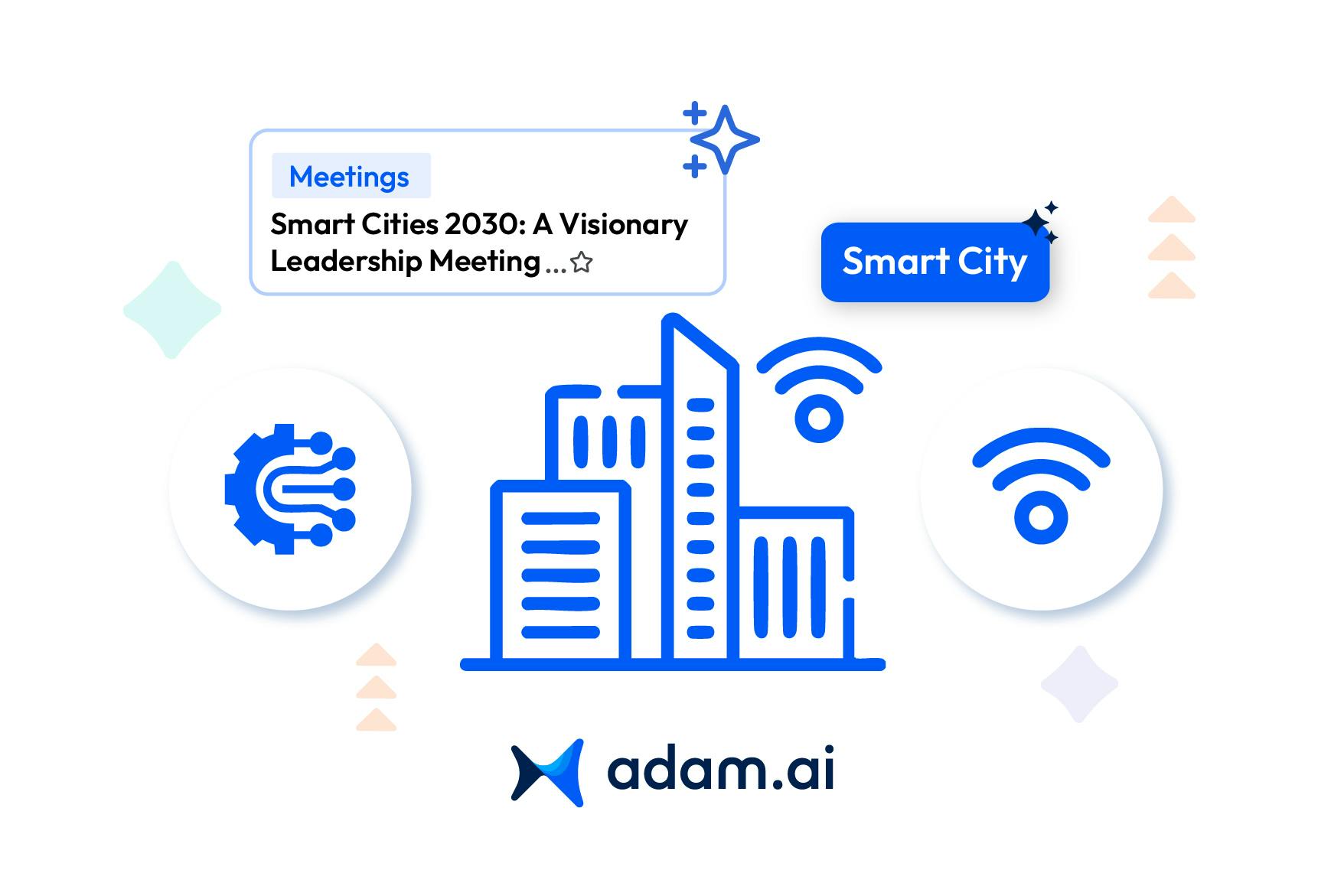
Smart cities are no longer a vision of the future; they are being built today with AI and IoT at their core. From traffic systems to energy grids, technology is redefining how urban areas operate. But with these advancements come challenges: data security risks, infrastructure costs, and ethical concerns that cities must navigate.
This article explores how AI and IoT are transforming urban life, the real-world innovations driving smart city initiatives, and the emerging technologies shaping the future.
What defines a smart city, and why are AI and IoT fundamental to its development?
A smart city is an urban environment that leverages advanced technologies, primarily Artificial Intelligence (AI) and the Internet of Things (IoT), to optimize infrastructure, enhance public services, and improve the overall quality of life for its residents. The goal of a smart city is to create a more efficient, sustainable, and responsive urban ecosystem that can adapt in real time to the needs of people, businesses, and governments.
Key features of a smart city
- Connected infrastructure: IoT-enabled sensors, smart grids, and automated systems that provide real-time data on transportation, energy, and utilities.
- AI-driven decision making: AI analyzes vast datasets from IoT devices to optimize traffic flow, predict infrastructure failures, and improve resource allocation.
- Sustainability and energy efficiency: Smart grids, AI-driven waste management, and optimized energy distribution help reduce emissions and operational costs.
- Enhanced public safety and security: AI-powered surveillance, automated emergency response systems, and predictive analytics help cities prevent and respond to crises.
- Digital governance and citizen engagement: AI and IoT improve government decision-making by using data-driven insights, enabling seamless e-governance and real-time communication with citizens.
Why AI and IoT are fundamental to smart cities
AI and IoT are the backbone of smart city development because they convert raw data into actionable insights that improve urban efficiency. Here’s how:
- IoT collects data:
IoT sensors track traffic patterns, air quality, energy consumption, and waste levels in real-time, providing cities with constant feedback loops to improve services. - AI processes and analyzes data:
AI algorithms detect patterns, predict issues before they occur (such as traffic congestion or infrastructure breakdowns), and recommend proactive solutions. - Automation and real-time adjustments:
AI-driven automation ensures smart traffic lights optimize flow, smart buildings adjust energy use, and predictive analytics improve public safety measures. - Scalability and long-term growth:
AI and IoT allow cities to expand smart services without requiring major overhauls, enabling continuous improvement and innovation.
How do AI and IoT enhance urban infrastructure, mobility, and energy management?
AI and IoT form the foundation of modern smart cities, transforming how infrastructure is managed, how people move, and how energy is distributed. IoT devices collect real-time data, while AI analyzes and optimizes operations, making cities more efficient, sustainable, and responsive to challenges.
1. AI and IoT in urban infrastructure
Smart infrastructure uses AI and IoT to improve public utilities, transportation networks, and essential services. Cities leverage these technologies to automate maintenance, reduce costs, and enhance service delivery.
Key applications:
- Predictive maintenance: IoT sensors on bridges, roads, and public buildings detect wear and tear, while AI predicts potential failures, allowing for proactive repairs before issues escalate.
- Smart waste management: IoT-enabled trash bins monitor fill levels, and AI optimizes waste collection routes to reduce costs and environmental impact.
- Water and utility management: AI analyzes data from IoT-connected water pipes to detect leaks and abnormal usage, ensuring efficient distribution and preventing waste.
2. AI and IoT in urban mobility
Traffic congestion and inefficient transportation systems cost cities billions annually. AI and IoT work together to optimize traffic flow, enhance public transit, and improve urban mobility.
Key applications:
- Smart traffic management: IoT cameras and sensors collect real-time traffic data, and AI adjusts traffic lights and reroutes vehicles to reduce congestion.
- AI-powered public transport: AI analyzes IoT data from buses, trains, and ride-sharing services to optimize schedules, reduce wait times, and increase efficiency.
- Autonomous vehicles and smart parking: AI-driven self-driving cars use IoT-enabled road sensors to navigate safely, while smart parking systems detect available spots and guide drivers, reducing fuel consumption.
3. AI and IoT in energy management
Energy efficiency is a core pillar of smart cities, and AI combined with IoT enables sustainable, data-driven energy distribution.
Key applications:
- Smart grids: IoT sensors monitor power demand, and AI automatically adjusts electricity distribution to prevent blackouts and reduce waste.
- Renewable energy optimization: AI predicts solar and wind energy production, balancing renewable sources with traditional power grids.
- Intelligent building automation: AI-driven HVAC and lighting systems adjust based on occupancy and weather, reducing energy use in offices and homes. ust like smart cities, the digital transformation in the oil and gas sector is leveraging AI and IoT to optimize operations, enhance efficiency, and improve decision-making.
What are the biggest benefits of AI-driven smart cities?
AI-driven smart cities optimize resources, reduce costs, and improve urban living by leveraging real-time data and automation. From sustainability to public safety, AI transforms how cities function, making them more efficient, secure, and resilient.
1. Sustainability and energy efficiency
- Smart grids balance energy demand and reduce waste.
- AI forecasts solar and wind energy production, integrating renewables effectively.
- AI-driven HVAC and lighting cut energy consumption in buildings.
2. Traffic and mobility optimization
- AI analyzes real-time traffic data, adjusting signals and rerouting vehicles.
- Public transit schedules adapt dynamically based on commuter demand.
- AI-powered smart parking reduces congestion and fuel waste.
3. Public safety and emergency response
- Predictive analytics detect crime hotspots and enhance law enforcement efficiency.
- AI-driven disaster response systems provide real-time alerts for floods, fires, and earthquakes.
- Smart surveillance helps detect and prevent security threats.
4. Waste and water management
- AI optimizes waste collection routes, reducing fuel consumption and costs.
- IoT sensors detect leaks in water systems, preventing resource waste.
5. Digital governance and citizen engagement
- AI-powered chatbots and platforms streamline public services and e-governance. Government and enterprise leaders can enhance productivity by reducing meeting fatigue with AI, ensuring discussions remain focused and action-oriented.
- Smart city dashboards offer real-time insights on urban operations. Implementing smarter meeting agendas can help urban planning teams and city officials keep discussions focused, ensuring meetings drive meaningful progress.
How is AI transforming decision-making in city governance and enterprise operations?
AI is revolutionizing how governments and enterprises manage cities, making decision-making faster, more data-driven, and efficient. From urban planning to business operations, AI-driven insights help leaders optimize resources, reduce costs, and improve citizen services.
1. AI in smart city governance
AI empowers governments to make real-time, data-backed decisions, improving public services and urban management.
- Predictive policy and planning: AI analyzes trends in traffic, energy use, and infrastructure maintenance, helping governments anticipate needs and allocate resources proactively.
- Smart public services: AI-powered chatbots and virtual assistants handle citizen inquiries, reducing administrative workloads. Implementing AI-driven meeting strategies can lead to a significant ROI from reduced meeting time, allowing smart city officials to allocate resources more effectively.
- E-governance and automation: AI automates permit approvals, legal documentation, and municipal workflows, improving efficiency. By incorporating AI-powered meeting tools, smart cities can enhance collaboration among stakeholders, improving governance efficiency. Cities can take inspiration from digital transformation in project management, where AI-driven automation enhances efficiency, governance, and collaboration. Government officials can improve efficiency by leveraging machine learning for meeting preparation, ensuring well-structured discussions that drive actionable outcomes.
2. AI in enterprise operations
Businesses leverage AI to streamline processes, enhance decision-making, and improve operational efficiency.
- Predictive analytics for business strategy: AI forecasts market trends, helping enterprises optimize investments and resource allocation. Universities and innovation hubs within smart cities can benefit from AI in research project management to enhance data-driven decision-making and resource allocation.
- AI-powered risk management: AI detects fraud, cybersecurity threats, and compliance risks, minimizing business disruptions. Leveraging AI in meeting management enables city officials to track decisions, follow up on action items, and ensure policy discussions translate into tangible results.
- Automated business intelligence: AI processes large datasets from multiple departments, providing executives with actionable insights for strategic decision-making. Similarly, the shift from traditional banking to fintech demonstrates how AI-driven innovation is reshaping industries by automating operations and improving user experiences.
3. AI in crisis and emergency management
Governments and businesses use AI to respond to crises faster and minimize disruptions.
- Disaster prediction and response: AI predicts natural disasters, traffic accidents, and cybersecurity threats, enabling proactive action.
- Smart surveillance and security: AI-driven facial recognition and anomaly detection improve public safety.
- AI in healthcare and emergency services: AI-powered ambulance dispatch systems optimize response times in emergencies.
How do real-world smart city initiatives improve governance and citizen engagement?
AI and IoT are reshaping urban governance by enabling real-time decision-making, automating services, and enhancing citizen engagement. Smart cities worldwide are using these technologies to improve public services, transparency, and civic participation, making governance more efficient and responsive.
1. AI and IoT in digital governance: Automating public services
Smart cities leverage AI-powered automation and IoT data to make government services more accessible and efficient.
- Smart public portals: AI-driven e-governance platforms streamline processes like permit applications, tax filings, and legal documentation.
- AI chatbots for citizen services: Governments use AI chatbots to handle inquiries, complaints, and administrative requests, reducing bureaucratic delays.
- IoT in smart administration: Sensors track real-time energy use, traffic, and water supply, helping officials make data-driven policy decisions.
Example: Saudi Arabia’s SDAIA (Saudi Data & AI Authority) integrates AI into government operations, digitizing services and automating decision-making for faster, more efficient governance.
2. Real-time citizen engagement and feedback
AI and IoT-powered platforms enable two-way communication between governments and citizens, fostering trust and accountability.
- AI-driven civic apps: Citizens report issues (potholes, traffic lights, and waste management problems) through AI-powered apps, triggering automated city responses.
- Smart voting and digital consultations: AI analyzes public sentiment and gathers citizen input for policy-making and urban planning. By using NLP for stakeholder sentiment analysis, city leaders can better gauge public sentiment, improving policy-making and governance.
- IoT-powered smart feedback systems: Interactive kiosks and AI-driven surveys help cities gather real-time feedback on public services.
Example: Barcelona’s Decidim platform allows residents to participate in decision-making, shaping city projects through digital voting and AI-powered consultations.
3. AI in smart law enforcement and public safety
Cities use AI and IoT to enhance security, predict crime trends, and ensure safer public spaces.
- Predictive policing: AI analyzes crime patterns to allocate police resources where they are needed most.
- Smart Surveillance: AI-enhanced cameras detect suspicious activities, traffic violations, and emergencies in real time.
- Disaster response and emergency alerts: AI predicts floods, earthquakes, and fire risks, alerting citizens through IoT-connected warning systems.
Example: Dubai’s Smart Police Stations use AI-driven crime detection and automated reporting systems, reducing administrative load on officers while improving security.
What challenges must cities overcome when adopting AIoT solutions?
While AI and IoT (AIoT) are transforming cities, their adoption comes with significant challenges in security, cost, and ethics. Governments and enterprises must address these concerns to ensure trust, sustainability, and efficiency in smart city projects.
1. Security and privacy risks
AIoT systems collect and process vast amounts of sensitive city and citizen data, making them prime targets for cyber threats. As AI and IoT become integral to urban development, addressing cybersecurity challenges in smart cities is crucial to prevent cyber threats that could compromise infrastructure and citizen data.
- Cybersecurity vulnerabilities: IoT devices are often poorly secured, making them easy targets for hacking, data breaches, and ransomware attacks.
- Surveillance concerns: AI-driven surveillance raises privacy issues, especially in facial recognition and public monitoring.
- Data protection and compliance: Cities must navigate regulations like GDPR (Europe) or SDAIA guidelines (Saudi Arabia) to protect citizen data.
Example: In 2021, a cyberattack on a Florida water treatment facility showed how poorly secured IoT systems can be exploited to disrupt essential services.
Solution: Governments must implement strong encryption, AI-powered threat detection, and strict access controls to secure AIoT ecosystems.
2. High costs and scalability issues
Deploying AIoT solutions requires significant upfront investment in infrastructure, training, and maintenance.
- Infrastructure costs: Smart city projects require high-speed networks (5G), edge computing, and IoT sensors, leading to budget concerns.
- Ongoing maintenance and upgrades: AI systems need constant updates to remain effective, and IoT devices have limited lifespans, leading to recurring costs.
- Scalability challenges: Expanding AIoT projects to entire cities is complex, requiring seamless integration across multiple agencies and service providers.
Example: India’s Smart Cities Mission faced delays due to budget constraints, forcing cities to scale down AIoT deployments in early stages.
Solution: Governments can partner with private tech firms, adopt cloud-based AI solutions, and implement phased rollouts to manage costs.
3. Ethical and social concerns
The use of AIoT in smart cities raises ethical dilemmas around data ownership, bias, and surveillance.
- Bias in AI decision-making: AI models trained on biased datasets can lead to discriminatory policing, unfair housing policies, and biased hiring decisions.
- Job displacement and workforce challenges: AI-driven automation may replace traditional jobs, requiring reskilling initiatives.
- Public trust and transparency: Citizens fear AIoT will be used for mass surveillance, leading to resistance against smart city projects.
Example: AI-driven facial recognition in China sparked global debates on government overreach and privacy concerns.
Solution: Cities must ensure transparent AI decision-making, involve public consultations, and implement fair data governance policies.
What emerging technologies will shape the future of smart cities?
The future of smart cities will be driven by emerging technologies that enhance connectivity, security, and automation. Innovations like 5G, blockchain, edge computing, and AI-powered digital twins are revolutionizing how cities operate, making urban environments faster, safer, and more efficient.
1. 5G: The backbone of smart cities
5G enables ultra-fast, low-latency communication, essential for real-time AIoT applications.
- Faster data transmission: 5G processes IoT data in milliseconds, allowing instant traffic control, remote surgeries, and autonomous vehicles.
- Better network scalability: Supports millions of connected devices per square kilometer, making large-scale AIoT deployments feasible.
- Reliable public services: 5G enhances smart grids, emergency response, and surveillance systems, ensuring uninterrupted operations.
Example: In Saudi Arabia, NEOM is deploying 5G to power AI-driven urban infrastructure and autonomous mobility solutions.
2. Blockchain: Enhancing security and transparency
Blockchain ensures tamper-proof, decentralized data management, strengthening trust in smart city operations.
- Secure citizen data: Blockchain prevents identity theft and cyberattacks by decentralizing personal records.
- Transparent governance: Smart contracts enable automated, corruption-free government transactions.
- Decentralized energy trading: Cities can enable peer-to-peer energy sharing, letting residents buy/sell solar energy securely.
Example: Dubai’s Smart Dubai initiative is integrating blockchain to automate public services and create a fully digital government.
3. Edge computing: Faster AI decisions without cloud delays
Edge computing processes data locally instead of relying on cloud servers, reducing latency and improving efficiency.
- Real-time AI analytics: Edge AI enables instant traffic monitoring, predictive policing, and smart home automation.
- Reduces cloud costs: Offloading data processing lowers bandwidth use and infrastructure costs.
- Enhances privacy: Keeps sensitive citizen data on local devices, reducing the risk of breaches.
Example: Singapore is deploying edge AI in smart traffic systems, cutting congestion and reducing travel time by 15%.
4. AI-powered digital twins: Simulating city operations
Digital twins are AI-driven virtual replicas of cities, used for urban planning, disaster prediction, and infrastructure monitoring.
- Traffic and infrastructure simulations: Governments test new road layouts, energy grids, and construction projects virtually before real-world implementation.
- Disaster preparedness: AI analyzes digital twin data to predict floods, fires, and pollution trends.
- Smart building optimization: Monitors real-time air quality, temperature, and energy efficiency in large commercial spaces.
Example: Saudi Arabia’s NEOM is integrating digital twins to plan urban development and optimize infrastructure performance before construction begins.
How does adam.ai support enterprises in managing smart city initiatives effectively?
Managing large-scale urban projects and smart city initiatives requires structured collaboration, data-driven decision-making, and efficient follow-ups. adam.ai empowers enterprises, governments, and IT leaders by providing an intelligent meeting management platform that enhances efficiency, accountability, and strategic alignment.
- Agenda management for smart city planning: Define structured meeting agendas to align stakeholders, urban planners, and government officials on key smart city initiatives.
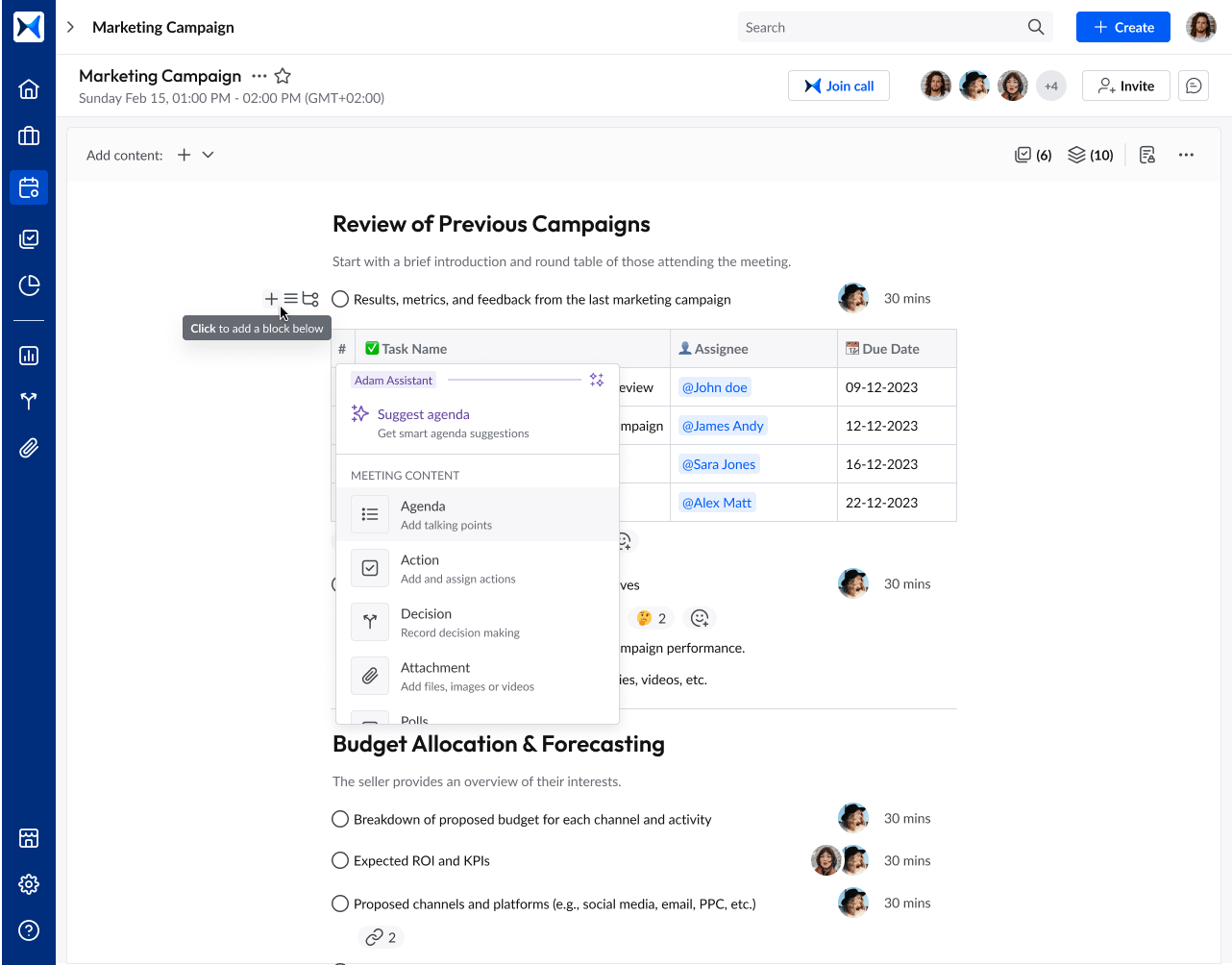
- Content collaboration for cross-sector coordination: Centralize urban development proposals, AI-powered traffic reports, and IoT data insights for real-time collaboration across teams.
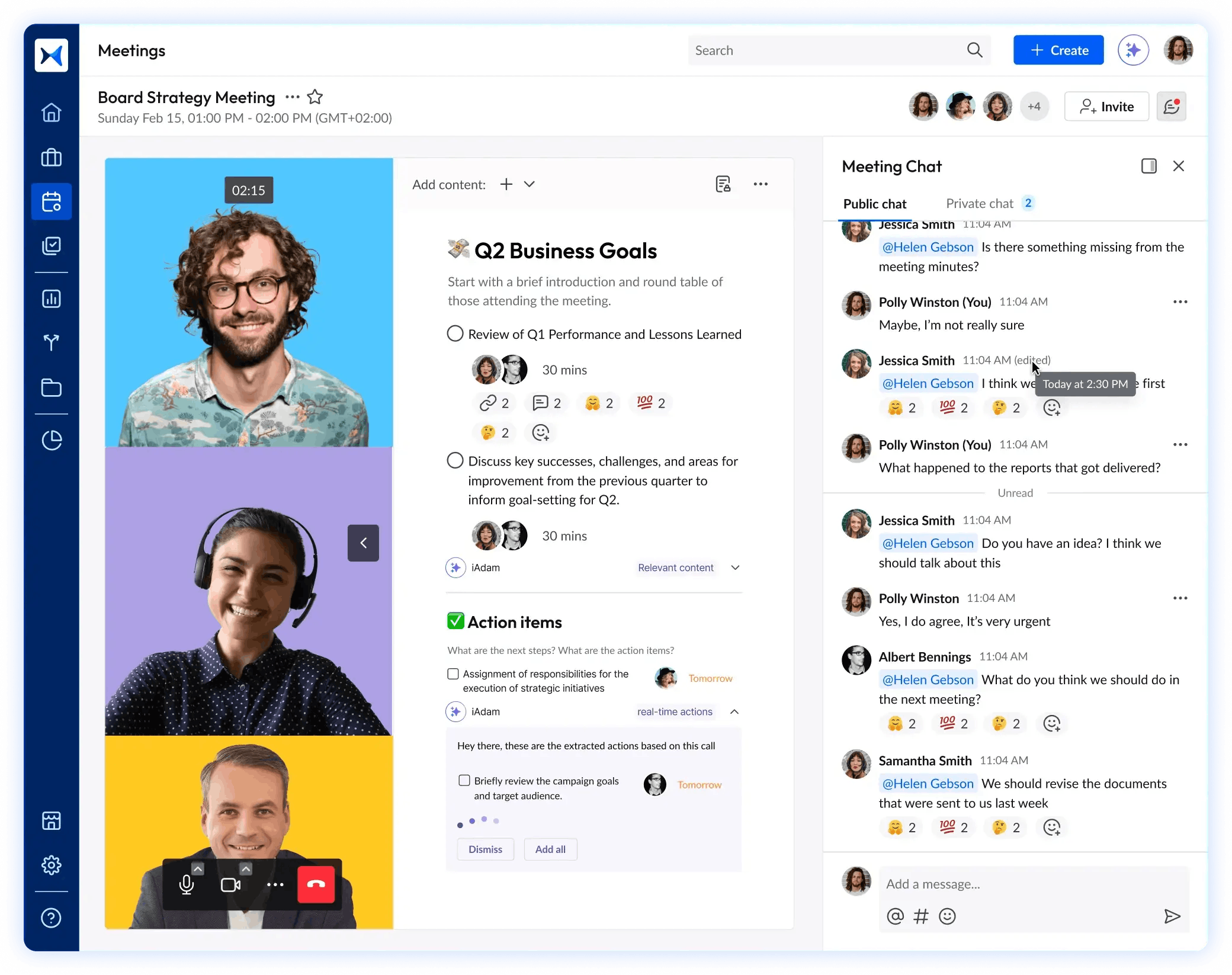
- Action management for smart governance execution: Assign and track infrastructure projects, AI-driven energy optimization plans, and public safety initiatives, ensuring accountability.
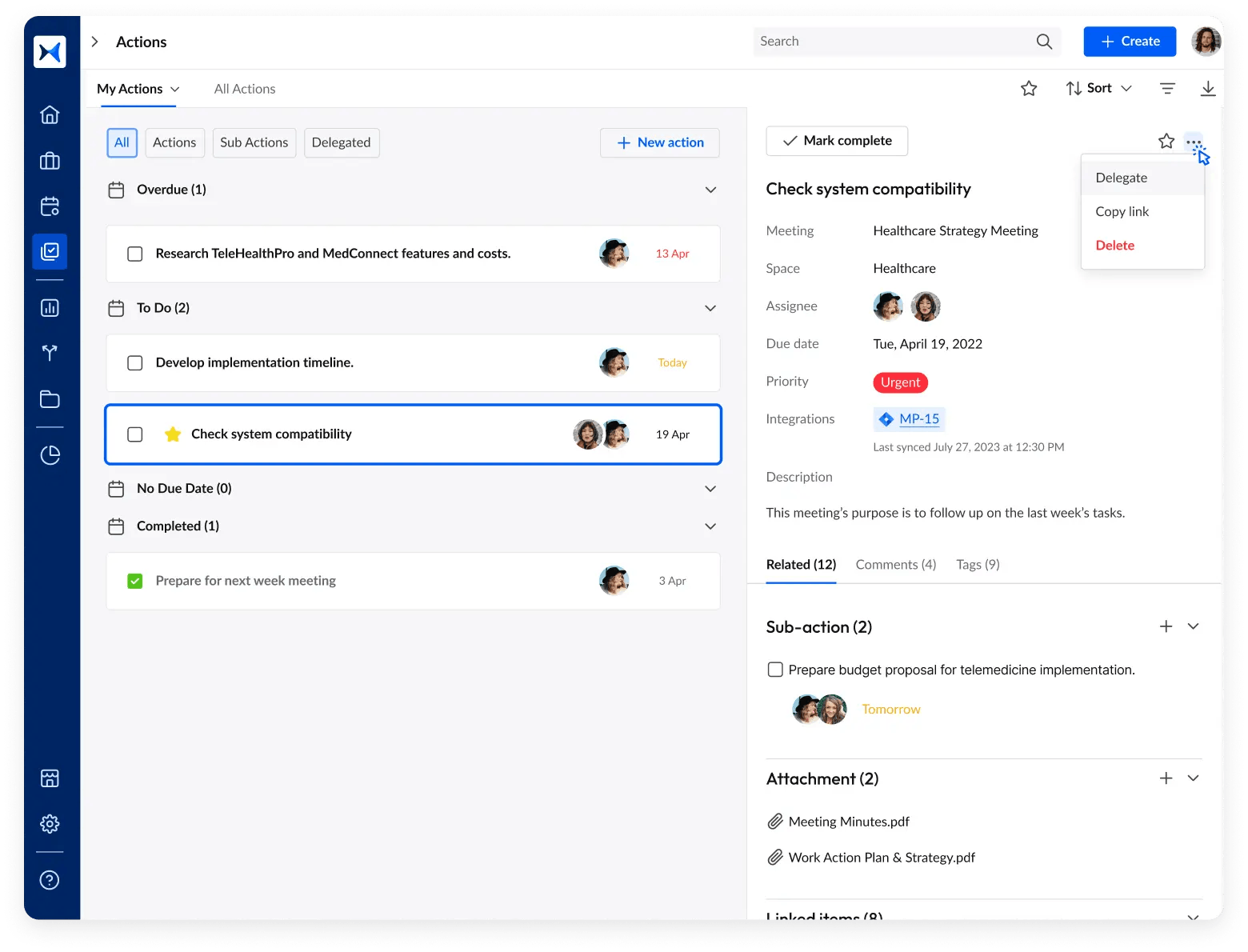
- Meeting minutes for compliance and transparency: Automate meeting documentation for city councils, IT leaders, and government agencies, ensuring accurate record-keeping and policy tracking.
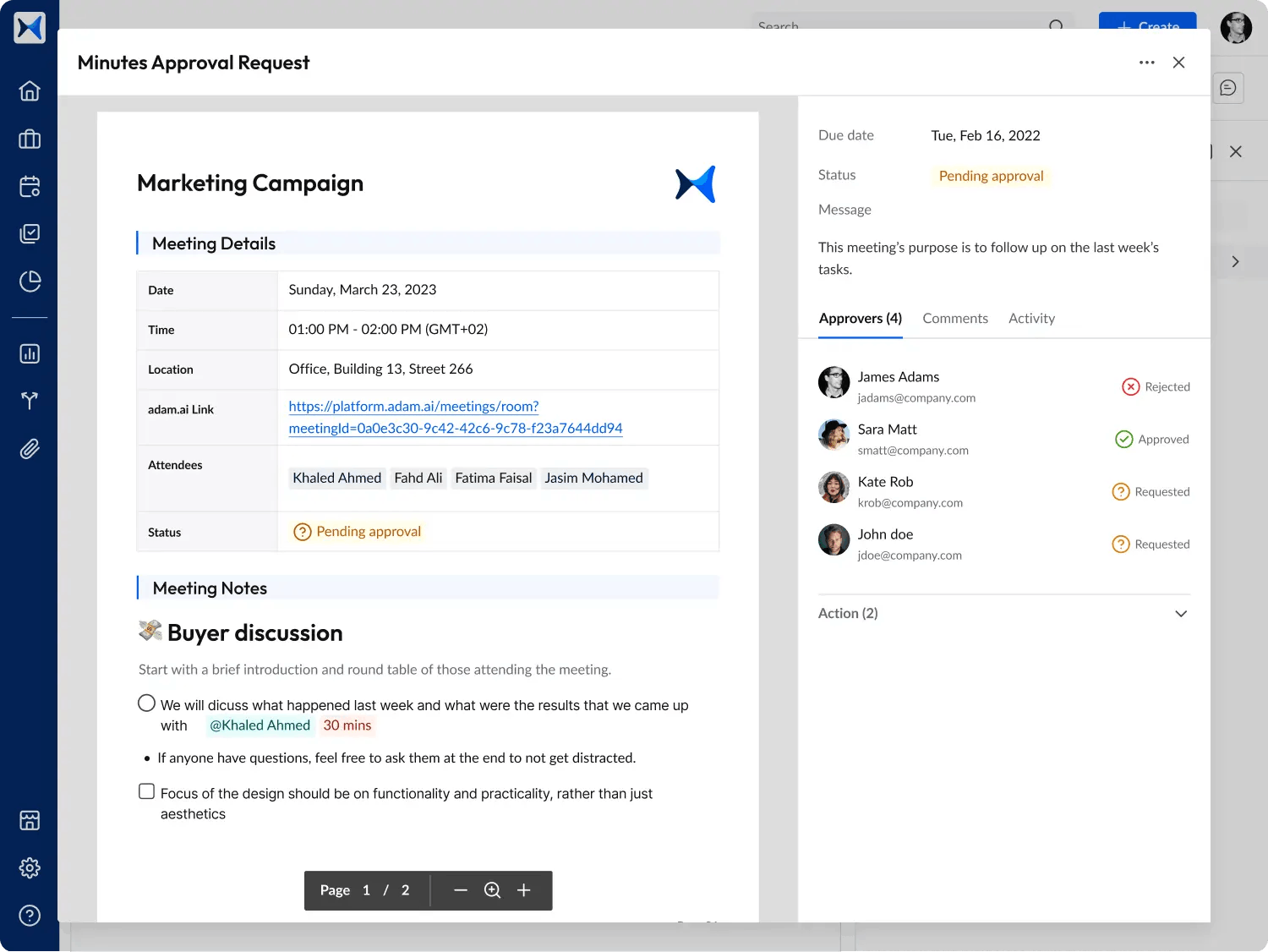
- Multi-space management for cross-departmental projects: Oversee multiple smart city initiatives across transport, energy, and security sectors within a single, structured digital workspace.
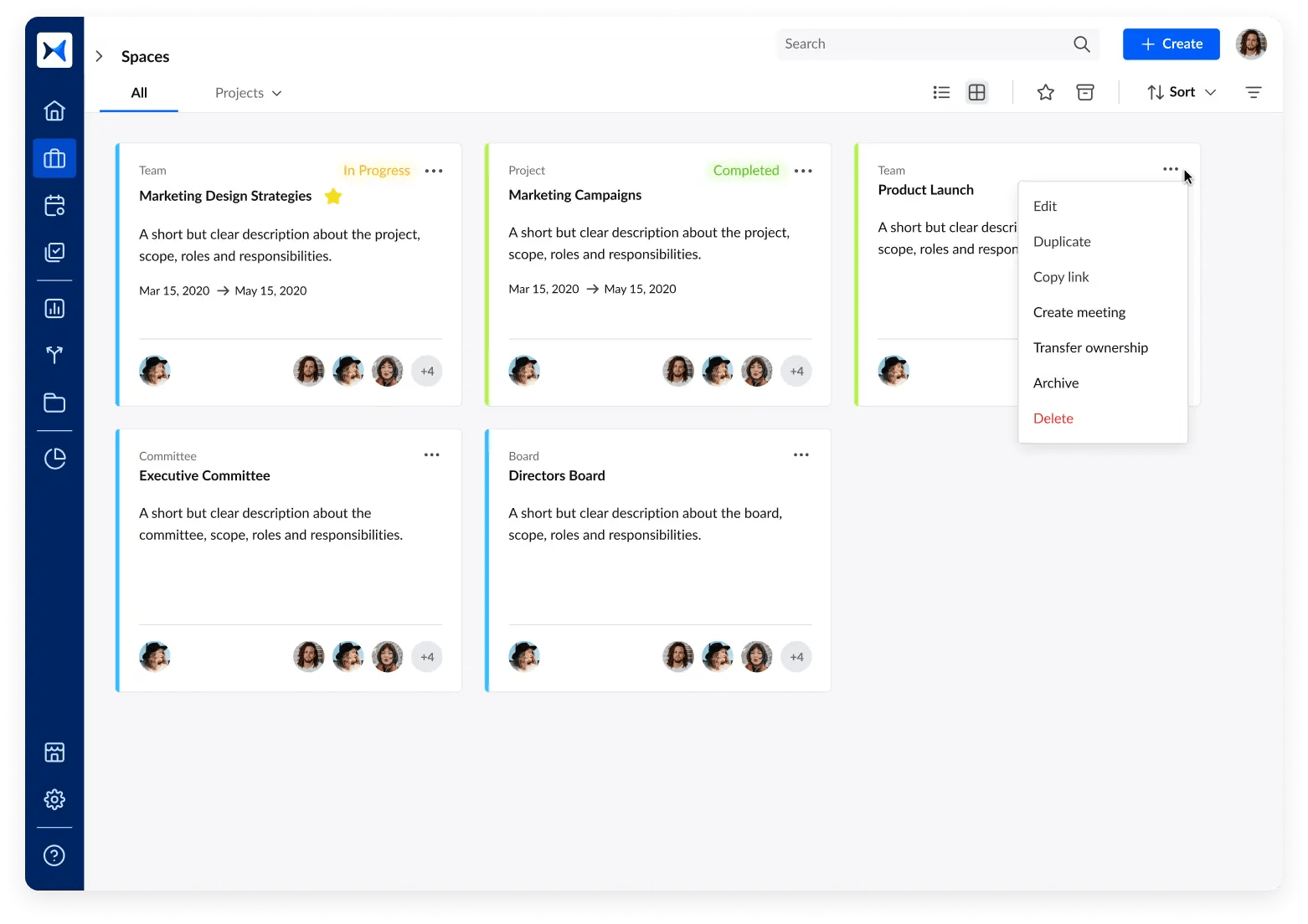
- Analytical dashboards for data-driven decisions: Gain real-time insights into project progress, AI adoption in urban planning, and smart city KPIs, driving informed, ROI-focused decision-making.
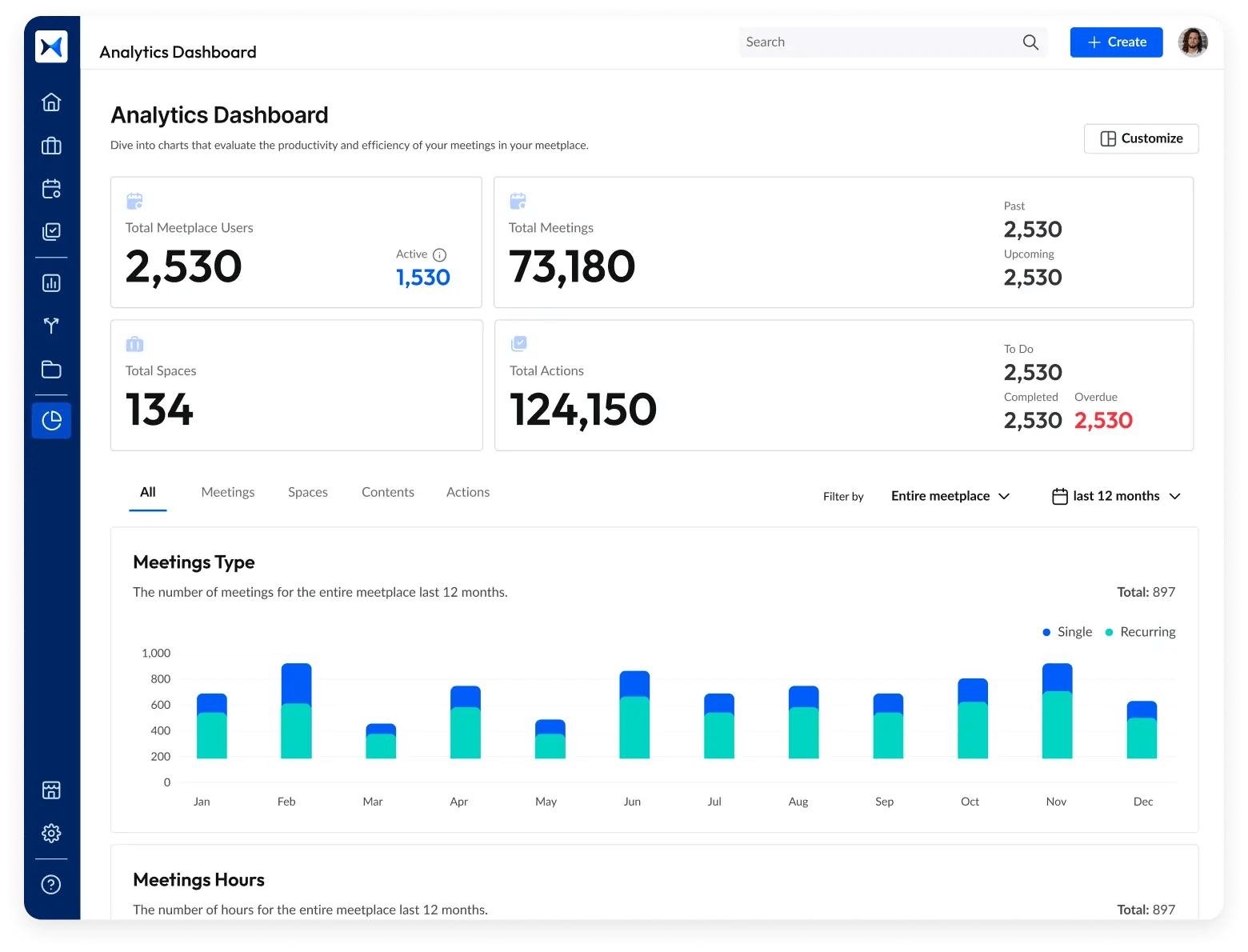
Transform how you conduct critical meetings—From meticulous preparation to effective execution and insightful follow-up, adam.ai integrates comprehensive analytics, full customization, and intuitive interfaces with powerful meeting management tools.
Easy onboarding. Enterprise-grade security. 24/7 dedicated support.
The bottom line
AI and IoT are redefining how governments, enterprises, and IT leaders plan, execute, and sustain urban innovations. To successfully navigate this transformation, enterprises and governments need modern tools that streamline collaboration, decision-making, and project execution.
And while there may be multiple solutions available, here is why adam.ai is the meeting management software platform you can trust:
- adam.ai is one of Atlassian Ventures' portfolio companies.
- In the meeting management software category on G2, adam.ai has been ranked a leader and a high performer for successive quarters in the past years.
- adam.ai has been included in the Forrester Report in the AI-enabled meeting technology landscape.
- adam.ai is trusted and used by powerful teams and organizations worldwide for all types of critical meetings, like board, committee, project management, and business development meetings.
- And most importantly, adam.ai integrates with your existing workflow, is SOC2 compliant, provides dedicated support and success, and has a free trial option.
Subscribe to adam.ai blog
Stay ahead with the latest insights—get our newest blog posts, tips, and updates sent straight to your inbox.